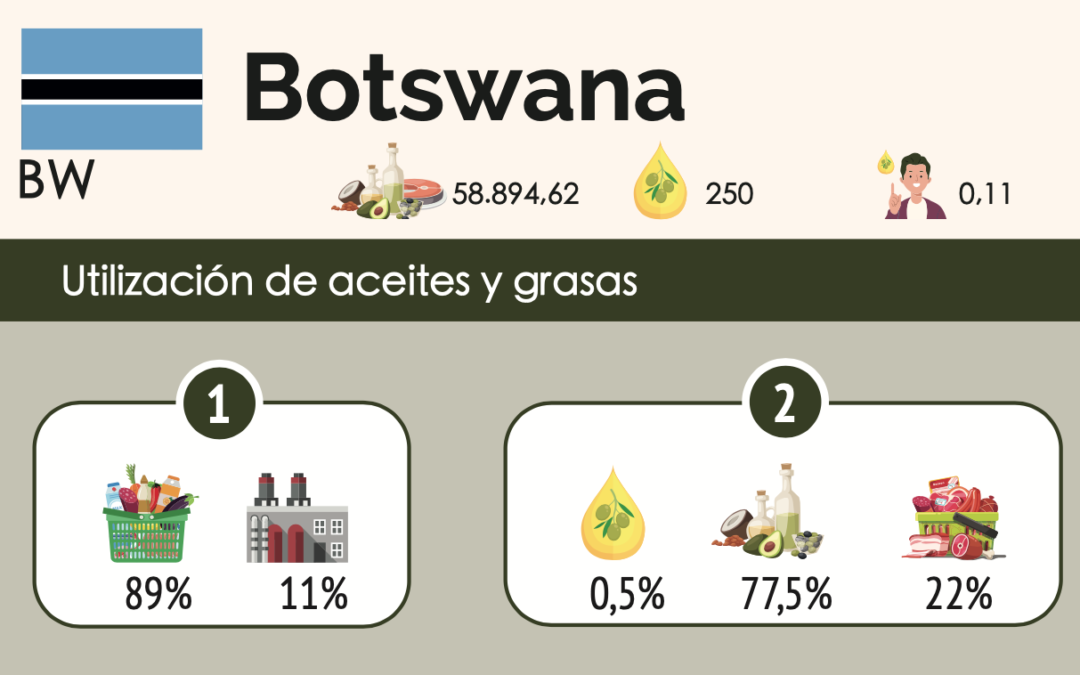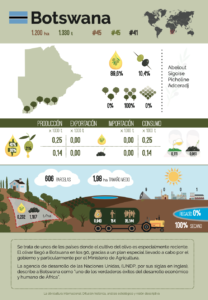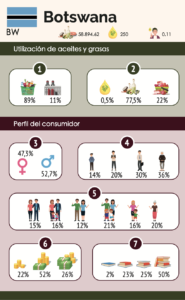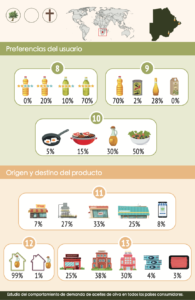Botswana is a country located in southern Africa with 2,551,625 inhabitants. It has a desert landscape called the Kalahari, which transforms into an abundant animal habitat during seasonal floods. It is one of the countries where olive cultivation is particularly recent. Olive growing arrived in this country around the 1990s, thanks to a special plan carried out by the government and particularly by the country’s Ministry of Agriculture. All olive plantations are currently located in the south of the country.
It has 1,200 ha of olive groves. It is ranked 45th both in terms of cultivation area and olive oil production. Of the total production, 89.6% is used to produce olive oil and 10.4% to produce table olives. The most predominant olive varieties in the area are Abelout, Sigoise, Picholine and Adceradj. All of its plantations are intensive, in addition to being 100% rainfed.
All of its oil and table olives are produced for consumption. It produces around 250 tons of olive oil and 140 tons of table olives. It does not export any of its production, nor does it import from other countries. Of the olive oil produced, 40% is high quality oil and the remaining 60% is of a lower quality, such as lampante olive oil.
The country owns some 606 plots of land, of which the average size is around 1.98 hectares. For each hectare there is a productivity of 0.232 tons of olive oil and 1.107 tons of table olives.
The turnover generated by the olive sector in this country is 0.943 million euros, which translates into 154 actual working days and 35,144 working days per year in the olive sector and related industries. Botswana currently has 9 mills and 1 bottling plant.
Regarding olive oil consumption in this country, 250 tons of olive oil are consumed per year, which translates into 0.11 liters per capita.
Of the total amount of edible animal and vegetable fats, the consumption of olive oil is not very significant, standing at 0.5% of the total. When comparing consumption between men and women, men consume a higher proportion than women, as they stand at 52.7% and women at 47.3%.
According to the age of consumers, the age range with the highest consumption of olive oil is over 65 years of age with 36%, followed by people between 34 and 49 years of age with a consumption of 30%. Olive oil consumption is lowest among people under 34 years of age.
According to family structure, middle-aged families with children consume the most olive oil (21%), followed by single or widowed people (20%). Consumption is lowest in middle-aged families without children (12%).
Consumption, according to income level, predominates in those individuals who have an average income (52%) or high income (26%). In addition, those individuals who have higher education, such as university education, consume significantly more oil than those who do not have any type of education. Those with education stand at 50% and those without at 2%.
According to the category of oils, the consumption of extra virgin olive oil predominates in a quite important way, amounting to 70%. Olive pomace oil is not consumed at all in this country. PET containers are the most popular form of consumption at 70%, followed by glass at 28%..
Half of olive oil consumption is used raw for dressing, followed by its use in cooking (30%). Olive oil is least used for frying (5%).
According to the type of establishment where olive oil is purchased, the highest proportion is in supermarkets (33%), followed by olive oil mills, bottling plants, bars and other points of sale (27%). Eight percent of olive oil consumers purchase olive oil through the Internet.
99% of people consume olive oil inside the home, the remaining 1% do so outside the home. People who consume it outside the home tend to do so in places such as collectivities (38%), hotels (30%) or bars and restaurants (25%).
Although consumption in Botswana is quite insignificant, it tends to be of high quality oils.




